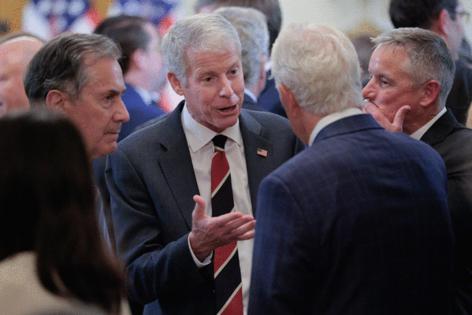Worker shortage looms over new US nuclear power focus
Published in News & Features
WASHINGTON — As the U.S. faces increasing demands for energy, the federal government has poured funding and regulatory support into the nuclear industry with the hopes of accelerating the development and deployment of new technologies. But an aging nuclear power workforce and shortage of qualified employees could pose a challenge to those goals.
“Lowering energy costs for Americans means developing and deploying available clean energy while supporting the reliability of our nation’s electrical grid. That includes nuclear energy,” Sen. Martin Heinrich, D-N.M., said in an email Tuesday. “We need to address supply chain and workforce constraints by expanding opportunities for apprenticeships in the skilled trades and supporting our universities’ science and engineering departments.”
Nuclear energy has been a Trump administration priority since early this year. In February, his energy secretary, Chris Wright, issued a secretarial order declaring an “American nuclear renaissance.”
“As global energy demand continues to grow, America must lead the commercialization of affordable and abundant nuclear energy,” Wright said, adding the DOE would work “creatively to enable the rapid deployment and export of next-generation nuclear technology.”
But the overarching federal goal of quadrupling nuclear capacity over the next 25 years will require a tripling of the workforce, according to the DOE’s Energy Workforce Advisory Board.
To achieve the administration’s goals “the Department must help remove barriers that impact nuclear employers’ abilities to deploy new nuclear technologies,” the board said in a report issued in July. It included as barriers an aging workforce, high retirement rates, a shortage of qualified workers joining the industry and a lack of training infrastructure for technical jobs.
“These challenges are expected to be exacerbated by rapid advancements in technology and advanced training required to manage next-generation reactors and small modular reactors,” the report said.
Fission and fusion
There are two kinds of nuclear power: fission and fusion.
Nuclear fission occurs during the split of enriched uranium atoms, a process that releases large amounts of heat and radiation. In a nuclear reactor, that heat boils water, which drives steam turbines to create electricity. Fission is the only commercially available form of nuclear power in the U.S., with 94 reactors accounting for about 19% of the nation’s electricity production, according to the Energy Information Administration.
Advanced modular reactors, now under development across the country, are designed to harness fission reactions in smaller, more scalable designs intended to be safer than traditional nuclear facilities. The Trump administration wants at least three advanced modular reactors to reach criticality by July 4, 2026 — a goal industry insiders have called ambitious.
“We have aggressive goals and aggressive timelines,” Craig Piercy, CEO American Nuclear Society, said in a recent interview. ANS is a professional nuclear worker organization, with a focus on workforce development.
But, Piercy added, as nuclear companies start to line up orders for the advanced reactors, an “inflection point” of increased hiring and significant expansion is likely to follow.
“Everyone recognizes the long-term need for nuclear is there,” he said. “It’s not a question of ‘if’ anymore, it’s a question of how much, how fast.”
Development of the second type of nuclear power — fusion — is further away.
Fusion requires the forcing of hydrogen atoms together using intense heat and pressure, mimicking the processes that power the sun. The amount of energy released through nuclear fusion is several times greater than power coming from currently available fission reactors, with the added benefit of not creating nuclear waste.
Wright has said fusion is the future. His department recently released a roadmap to developing fusion technology with the aim of making it commercially available in the mid-2030s. In Congress, Sens. John Curtis, R-Utah, and Maria Cantwell, D-Wash., recently introduced legislation that would extend manufacturing tax credits in the Inflation Reduction Act to include fusion energy components.
Fusion has seen a “very dramatic acceleration” of activity, said Columbia University Professor Carlos Paz-Soldan, who specializes in nuclear fusion. “With that increased activity has come an increased demand for workforce and for labor.”
Nuclear workforce priorities
The nuclear energy workforce has faced boom-and-bust cycles over decades, Paz-Soldan said.
“In periods of plenty, there were quite a number of people going in, and then there were periods of stagnation, where relatively few people were going in,” he said.
For fusion technology, he said, few people entered the workforce in the 1990s, so now there’s a “double-humped demographic situation, where we have a senior generation and a junior generation, but kind of nobody in between.”
But industry now must figure out how to turn the recently elevated interest in both types of nuclear energy into workforce development, Paz-Soldan said.
“It’s a matter of how much training are we actually able to provide given the limited number of people in the business of training,” he said. “The workforce is aging on both sides.”
Piercy, from the nuclear worker group, said industry leaders need to find not just highly educated nuclear engineers to produce the technology, but also people who can fill support roles but may be looking at careers in other sectors.
“A lot of the challenge here is not with the hardcore nuclear workforce, but it’s with skilled labor,’ he said. “It’s with other professional sectors — law, human resources, business, finance — all the other things that go into building a vibrant supply chain.”
Education, training, outreach
Piercy said his organization is trying to tackle the workforce issue from different approaches, such as retraining professionals with skills adjacent to the nuclear industry, developing certification opportunities for people without college degrees and using outreach programs to build interest among potential future workers starting as young as elementary school.
“We’re working to meet that demand, and then we’re also developing a system that would allow people to come from other parts of the economy over to nuclear that can get re-skilled quickly so that they can jump in and be productive.”
Still, industry isn’t working alone to solve the problem.
One of Trump’s executive orders related to nuclear development included provisions to encourage and fund apprenticeship programs and otherwise designate nuclear energy jobs as a “priority area for investment.”
That sentiment has echoed across Capitol Hill, where nuclear development has become a rare area of bipartisan interest and cooperation.
In the Senate, a bipartisan bill sponsored by Jim Risch, R-Idaho, along with Heinrich, Mike Lee, R-Utah, and Chris Coons, D-Del., would help develop an international nuclear workforce through cooperative training efforts. A version of that bill passed the Senate as part of the fiscal 2026 National Defense Authorization Act.
The House Science, Space and Technology Committee has taken an interest in staffing for fusion development. Ranking member Rep. Zoe Lofgren, D-Calif., has introduced legislation with Rep. Jay Obernolte, R-Calif., that would authorize a combined $30 million in grants over the next five years through the National Science Foundation and DOE to aid fusion workforce development.
Fusion, if achieved, “will change our world profoundly,” Lofgren said in an interview Tuesday.
“People were concerned, and understandably so, at some failures of old design nuclear plants,” she said. “But next gen nuclear is a completely different animal. And so we’re working together to try and support that.”
Curtis echoed that impression, saying in an email, “The nuclear power of our grandparents is not the nuclear we’re building today.”
“As energy demand grows dramatically, we’re seeing rare bipartisan momentum around nuclear because it delivers on what Americans want: energy that is affordable, reliable, and clean,” Curtis added. “I believe success will come not only through innovation, but by investing in the workforce and building trust in the communities that will power this next chapter of American energy.”
©2025 CQ-Roll Call, Inc., All Rights Reserved. Visit cqrollcall.com. Distributed by Tribune Content Agency, LLC.







Comments